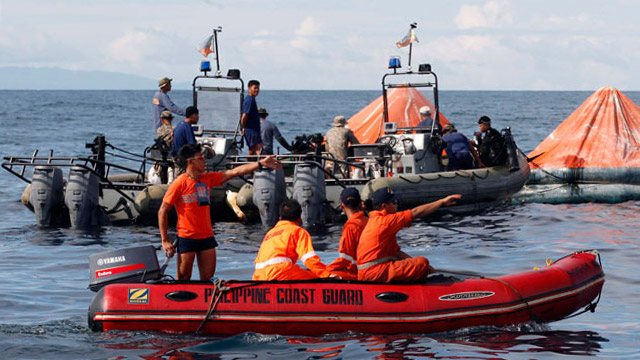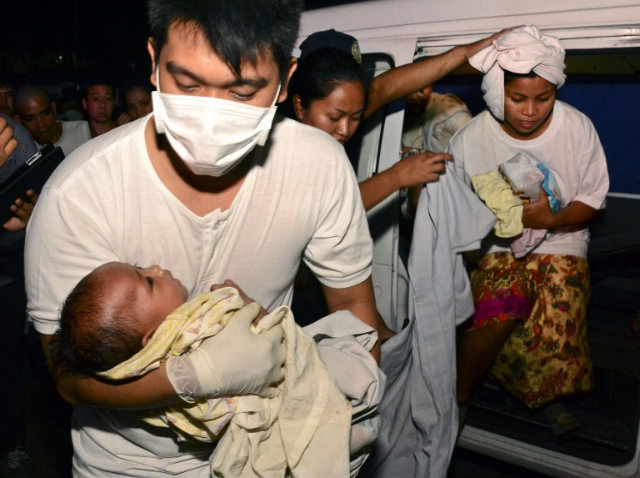SUMMARY
This is AI generated summarization, which may have errors. For context, always refer to the full article.

CEBU, Philippines (5th UPDATE) – Rescuers aboard helicopters and speed boats were desperately searching Saturday, August 17, for at least 172 people missing after a ferry sank in the Philippines, with at least 31 already confirmed dead as of 2:20 pm, according to the Philippine coastguard.
The St Thomas Aquinas ferry was carrying 870 passengers and crew when it collided with a cargo ship on Friday night in calm waters near the port of Cebu, the Philippines’ second biggest city, authorities said.
While 629 people had been rescued by early Saturday morning, 172 were still unaccounted for and 31 bodies had been retrieved, according to the coast guard’s headquarters in Manila.
In a statement, the owner of the passenger vessel said it is attending to all the concerns of the passengers: “2GO Group has has activated its emergency onsite operations center at port to address all possible requirements for emergencies like this including providing assistance to survivors.”
READ: 31 dead in ship collision in Cebu
One survivor, Maribel Manalo, 23, recounted to her brother the horror of suddenly being plunged into the cold water in darkness, and emerging from the chaos without her mother.
“She said there was a banging noise then the boat suddenly started sinking,” the brother, Arvin Manalo, told AFP.
“They quickly strapped on life jackets and then jumped into the dark sea. She said they felt like they were pulled under. My sister said she pushed our mother up, but they got separated.
“My sister was rescued. My sister knows how to swim, but my mother does not.”
He said their mother, 56, remained missing.
The accident occurred at 9 pm Friday in the mouth of a narrow strait leading into the port between two and three kilometres (1.2-1.8 miles) from shore, authorities said.

58 babies
Fifty-eight babies were among the passengers on board the ferry, according to the coastguard, and it was unclear how many of them survived.
Rear Admiral Luis Tuason, vice commandant of the Philippine coastguard, told DZMM radio just after sunrise there were hopes that some of the missing had been picked up by fishermen who had joined in the rescue effort, or were still at sea.
But Tuason said he expected the death toll would climb substantially.
“Yes, that will still be a big number,” he said.
Navy divers on a speed boat were scouring the sea on Saturday morning amid orange life rafts that had already been emptied, according to an AFP photographer on the scene.
Tuason said helicopters had also been deployed.
Local fisherman Mario Chavez told AFP he was one of the first people to reach passengers after the ferry sank.
“I plucked out 10 people from the sea last night. It was pitch black and I only had a small flashlight. They were bobbing in the water and screaming for help,” he said.
“They told me there were many people still aboard when the ferry sank… they told me many were sleeping. There were screams, but I could not get to all of them. It was difficult to find them. I felt really bad.”
Violated rules?
Rachel Capuno, a security officer for the ferry’s owners, told Cebu radio station DYSS the vessel was sailing into port when it collided with the cargo ship.
“The impact was very strong,” she said, adding that the ferry sank within 30 minutes of the collision.
The cargo ship, Sulpicio Express 7, which had 36 crew members on board, did not sink.
Tuason said it appeared one of the vessels had violated rules on which lanes they should use when travelling in and out of the port.
“A big part of the investigation is how the captains maneuvered the ships,” he said.
Tuason said the captain of the Thomas Aquinas was among those rescued, and was being questioned.
The Thomas Aquinas was a “roll-on, roll-off” ferry, which allows vehicles to be driven aboard and is commonly used in the Philippines.
Ferries are one of the main modes of transport across the archipelago of more than 7,100 islands, particularly for the millions of people too poor to fly.
But sea accidents are common, with poor safety standards, lax enforcement and overloading typically to blame.
The world’s deadliest peacetime maritime disaster occurred in the Tablas Strait, near Marinduque, in 1987 when a ferry laden with Christmas holidaymakers collided with a small oil tanker, killing more than 4,300 people.
In 2008, a huge ferry capsized during a typhoon off the central island of Sibuyan, leaving almost 800 dead. – Rappler.com
Add a comment
How does this make you feel?
There are no comments yet. Add your comment to start the conversation.